Oil-Cooling Method of the Permanent Magnet Synchronous Motor for Electric Vehicle
Abstract
1. Introduction
2. Oil-Cooled Structure Model of Hub Motor
- It can ensure the safe and stable operation of the motor within the range of temperature rise and the operating environment;
- Fluid surface heat transfer coefficient is large enough, and heat exchange is sufficient, and efficient;
- The resistance coefficient of lubricating oil is small along the pipeline;
- The original structural elements of the motor should be kept as much as possible, especially the heat transfer path should be kept unchanged;
- Oil road section shape should be uniform, the number of elbows should be small, the local resistance of elbows should be as small as possible;
- Easy to use and maintain.
3. Temperature Field Simulation
- (1)
- due to the superposition of the axial silicon steel sheet of the motor, the thermal conductivity is small, so the axial thermal conductivity of the motor is ignored;
- (2)
- do not consider the heat dissipation of the end winding of the motor;
- (3)
- the assembly clearance between the outer surface of the stator and the housing and the clearance between the inner surface of the rotor and the shaft are ignored.
3.1. Analysis of Rated Operating Conditions Simulation Results
3.2. Analysis of Peak Operating Conditions Simulation Results
4. Motor Test Analysis
5. Conclusions
Author Contributions
Funding
Conflicts of Interest
References
- Staton, D.A.; Cavagnino, A. Convection Heat Transfer and Flow Calculations Suitable for Electric Machines Thermal Models. IEEE Trans. Ind. Electron. 2008, 55, 3509–3516. [Google Scholar] [CrossRef]
- Yan, H.; Xu, Y.; Zou, J. A Phase Current Reconstruction Approach for Three-Phase Permanent-Magnet Synchronous Motor Drive. Energies 2016, 9, 853. [Google Scholar] [CrossRef]
- Ye, L.; Tao, F.; Wen, X.H.; Yong, L.; Li, Y. Numerical Research on Hydraulic and Thermal Performance of the Motor Water Jackets Based on the Orthogonal Experiment. In Proceedings of the 2013 International Conference on Electrical Machines and Systems (ICEMS), Busan, Korea, 26–29 October 2013; pp. 860–863. [Google Scholar]
- Jiao, B.; Li, D.; Du, X.; Zhang, K. Performance Analysis and Experimentation of a Liquid-Cooled Eddy Current Retarder with a Dual Salient Poles Design. IEEE Trans. Energy Convers. 2014, 29, 84–90. [Google Scholar] [CrossRef]
- Lindh, P.M.; Petrov, I.; Semken, R.S.; Niemela, M.; Pyrhonen, J.J.; Aarniovuori, L.; Vaimann, T.; Kallaste, A. Direct Liquid Cooling in Low-Power Electrical Machines—Proof-of-Concept. IEEE Trans. Energy Convers. 2016, 31, 1257–1266. [Google Scholar] [CrossRef]
- Liu, M.; Li, Y.; Ding, H.; Sarlioglu, B. Thermal Management and Cooling of Windings in Electrical Machines for Electric Vehicle and Traction Application. In Proceedings of the 2017 IEEE Transportation Electrification Conference and Expo (ITEC), Chicago, IL, USA, 22–24 June 2017; pp. 668–673. [Google Scholar]
- Wu, W.; Hu, C.; Hu, J.; Yuan, S. Cooling for rolling Bearings: Flow visualization and temperature distribution. Applied. Thermal. Eng. 2016, 105, 217–224. [Google Scholar] [CrossRef]
- Chengye, L.; Kejun, J.; Yan, Z. Study on Temperature Rise Performance of Eddy Current Retarder in Automobile. In Proceedings of the 2010 International Conference on Future Information Technology and Management Engineering, Changzhou, China, 9–10 October 2010; pp. 550–553. [Google Scholar]
- Camilleri, R.; Howey, D.A.; McCulloch, M.D. Predicting the Temperature and Flow Distribution in a Direct Oil-Cooled Electrical Machine with Segmented Stator. IEEE Trans. Ind. Electron. 2016, 63, 82–91. [Google Scholar] [CrossRef]
- Jungreuthmayer, C.; Bauml, T.; Winter, O.; Ganchev, M.; Kapeller, H.; Haumer, A.; Kral, C. A detailed heat and fluid flow analysis of an internal permanent magnet synchronous machine by means of computational fluid dynamics. IEEE Trans. Ind. Electron. 2012, 59, 4568–4578. [Google Scholar] [CrossRef]
- Wang, R.J.; Heyns, G.C. Thermal Analysis of a Water-Cooled Interior Permanent Magnet Traction Machine. In Proceedings of the 2013 IEEE International Conference on Industrial Technology (ICIT), Cape Town, South Africa, 25–28 February 2013; pp. 416–421. [Google Scholar]
- Gao, X.; Low, T.; Liu, Z.; Chen, S. Robust design for torque optimization using response surface methodology. IEEE Trans. Magn. 2002, 38, 1141–1144. [Google Scholar] [CrossRef]
- Advanced Clean Cars Midterm Review. In Zero Emission Vehicle and Plug-in Hybrid Electric Vehicle Technology Assessment; California Energy: Sacramento, CA, USA, 2017.
- Qu, H.; Li, J.; Wang, Y.; Li, Z. Oil Cooling System for Motor for Compressor. BrevetCN104467288, 31 December 2014. [Google Scholar]
- Hwang, C.C.; Cheng, S.P.; Li, P.L. Design Optimization for Cogging Torque Minization and Efficiency Maximization of an SPM Motor. In Proceedings of the IEEE International Conference on Electric Machines&Drives, Antalya, Turkey, 3–5 May 2007; Volume 1, pp. 642–646. [Google Scholar]
- Wang, K.; Zhu, Z.Q.; Ombach, G. Synthesis of High Performance Fractional-Slot Permanent-Magnet Machines with Coil-Pitch of Two Slot-Pitches. IEEE Trans. Energy Convers. 2014, 29, 758–770. [Google Scholar] [CrossRef]
- Liu, R.; Thelin, P.; Nordlund, E.; Sadarangani, C.; Zheng, P. Research on the Cooling System of a 4QT Prototype Machine Used for HEV. IEEE Trans. Energy Convers. 2008, 23, 61–67. [Google Scholar]
- Polikarpova, M. Liquid Cooling Solutions for Rotating Permanent Magnet Synchronous Machines. Ph.D. Thesis, Lutpub, Lappeenranta, Finland, 21 November 2014. [Google Scholar]
- Li, Q.; Fan, T.; Wen, X.; Ning, P. An Analytical Approach to Magnet Eddy—Current Losses for Interior Permanent-Magnet Synchronous Machines during Flux Weakening. IEEE Trans. Magn. 2015, 8, 51. [Google Scholar]
- Caricchi, F.; Crescimbini, F.; di Napoli, A. Prototype of innovative wheel direct drive with water-cooled axial-flux PM motor for electric vehicle applications. IEEE Appl. Power Electron. 1996, 2, 764–770. [Google Scholar]
- Ulbrich, S.; Kopte, J.; Proske, J. Cooling Fin Optimization on a TEFC Electrical Machine Housing Using a 2-D Conjugate Heat Transfer Model. IEEE Trans. Ind. Electron. 2018, 65, 1711–1718. [Google Scholar] [CrossRef]
- Ishak, D.; Zhu, Z.; Howe, D. Eddy-current loss in the rotor magnets of permanent-magnet brushless machines having a fractional number of slots per pole. IEEE Trans. Magn. 2005, 41, 2462–2469. [Google Scholar] [CrossRef]
- Harumi, C.-K. JMAG-Designer Version 10—User’s Manual Solver; JSOL Corporation: Tokyo, Japan, 2010; Volume 25. [Google Scholar]
- Boglietti, A.; Cavagnino, A.; Staton, D.; Shanel, M.; Mueller, M.; Mejuto, C. Evolution and Modern Approaches for Thermal Analysis of Electrical Machines. IEEE Trans. Ind. Electron. 2009, 56, 871–882. [Google Scholar] [CrossRef]
- El-Refaie, A.; Harris, N.; Jahns, T.; Rahman, K. Thermal Analysis of Multibarrier Interior PM Synchronous Machine Using Lumped Parameter Model. IEEE Trans. Energy Convers. 2004, 19, 303–309. [Google Scholar] [CrossRef]
- Nerg, J.; Rilla, M.; Pyrhonen, J. Thermal Analysis of Radial-Flux Electrical Machines with a High Power Density. IEEE Trans. Ind. Electron. 2008, 55, 3543–3554. [Google Scholar] [CrossRef]
- Kral, C.; Haumer, A.; Lee, S.B. A Practical Thermal Model for the Estimation of Permanent Magnet and Stator Winding Temperatures. IEEE Trans. Power Electron. 2014, 29, 455–464. [Google Scholar] [CrossRef]
- Eason, G.; Noble, B.; Sneddon, I.N. On Certain Integrals of Lipschitz-Hankel Type Involving Products of Bessel Functions. Philos. Trans. R. Soc. A Math. Phys. Eng. Sci. 1955, 247, 529–551. [Google Scholar] [CrossRef]
- Liu, R.; Zheng, P.; Xie, D.; Wang, L. Research on the High Power Density Electromagnetic Propeller. IEEE Trans. Magn. 2007, 43, 355–358. [Google Scholar] [CrossRef]
- Boglietti, A.; Cavagnino, A.; Lazzari, M.; Pastorelli, M. A simplified thermal model for variable-speed self-cooled industrial induction motor. IEEE Trans. Ind. Appl. 2003, 39, 945–952. [Google Scholar] [CrossRef]
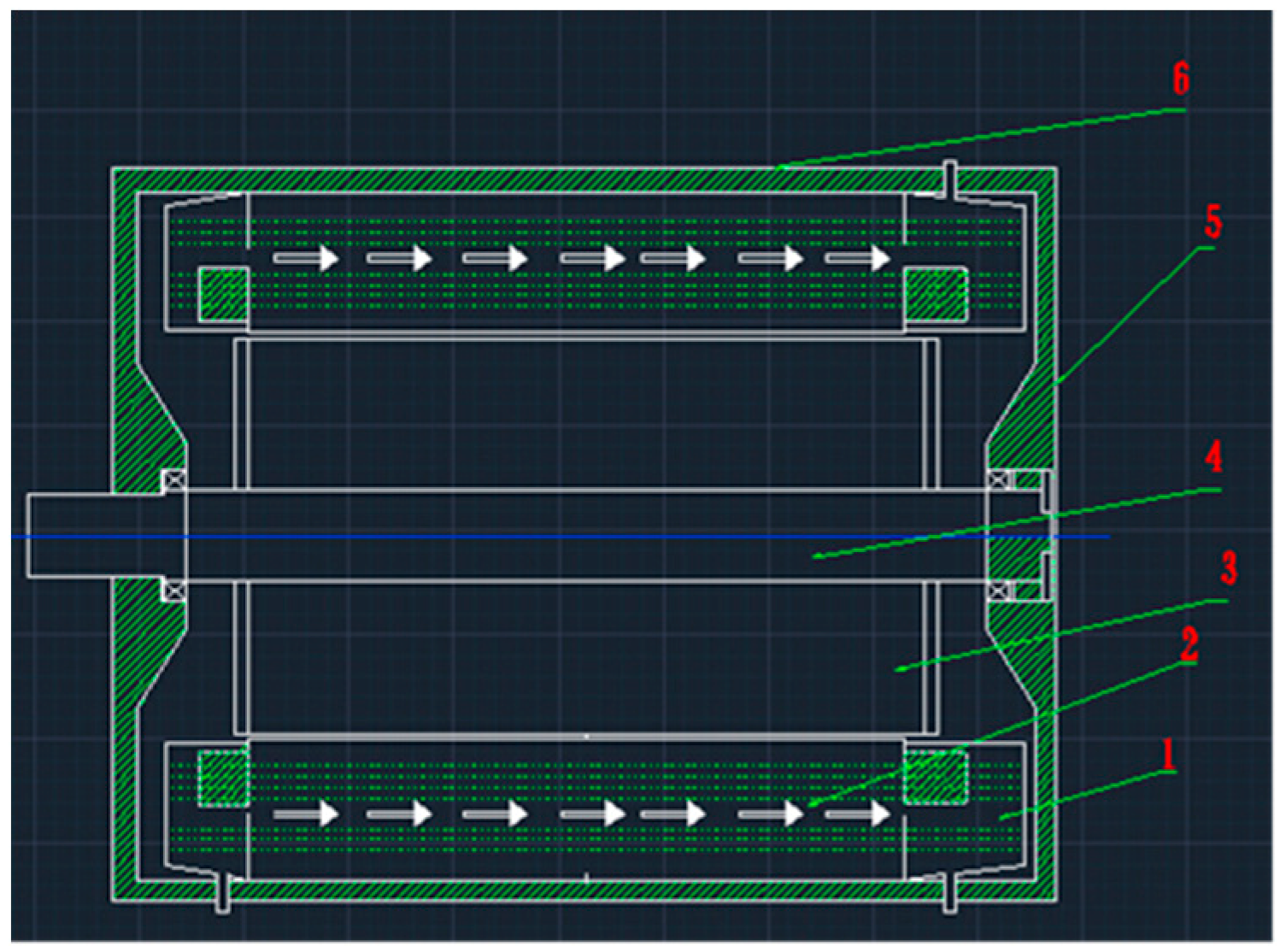
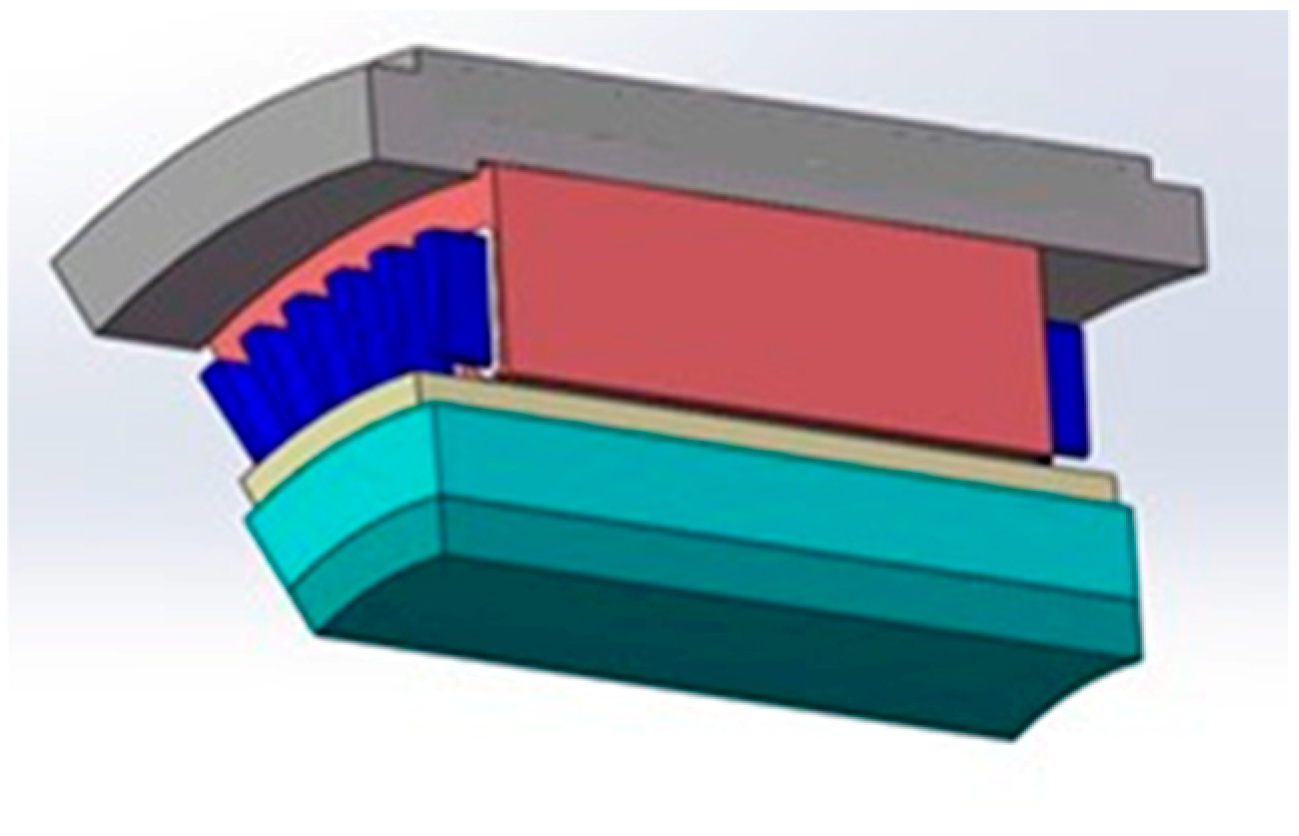

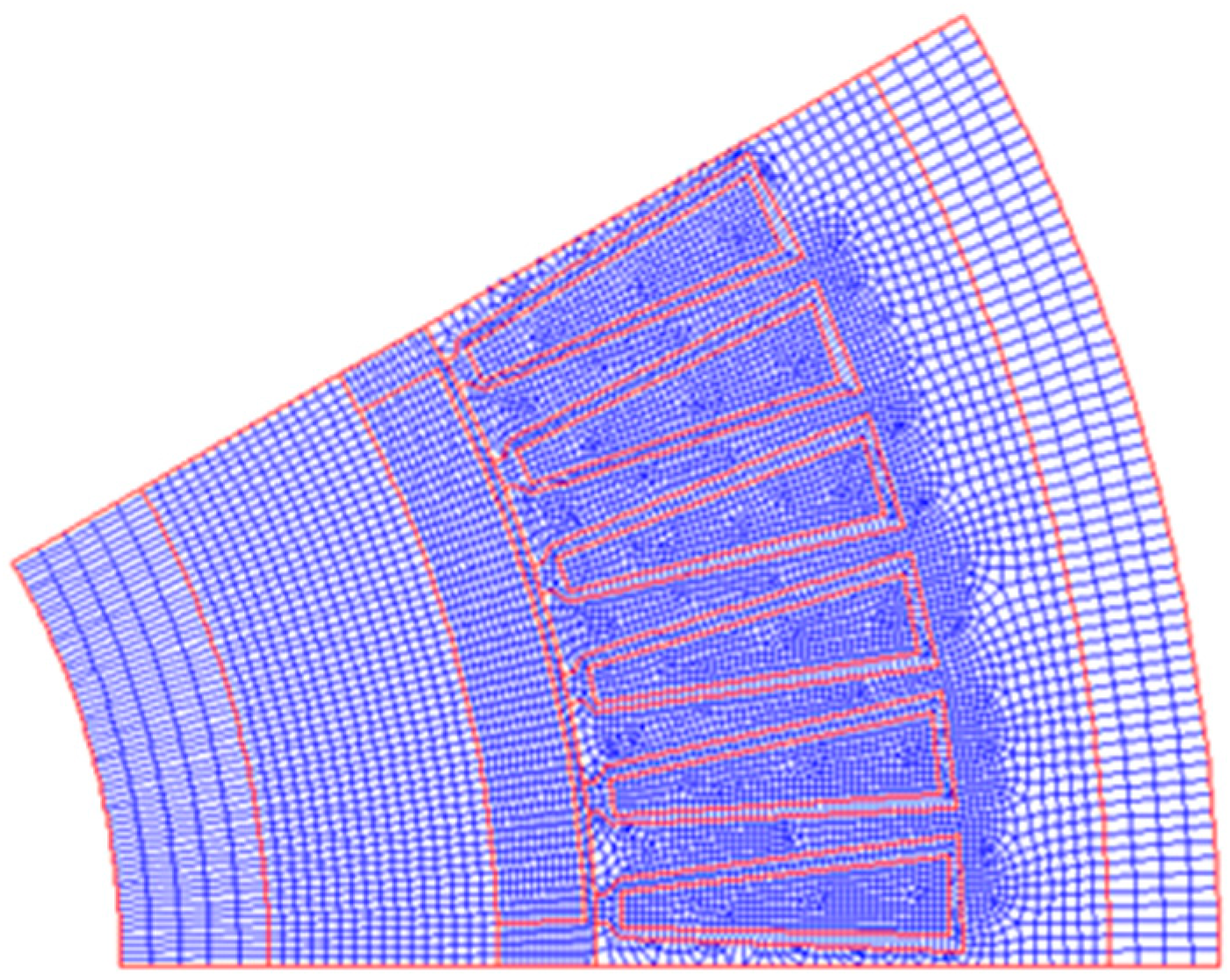
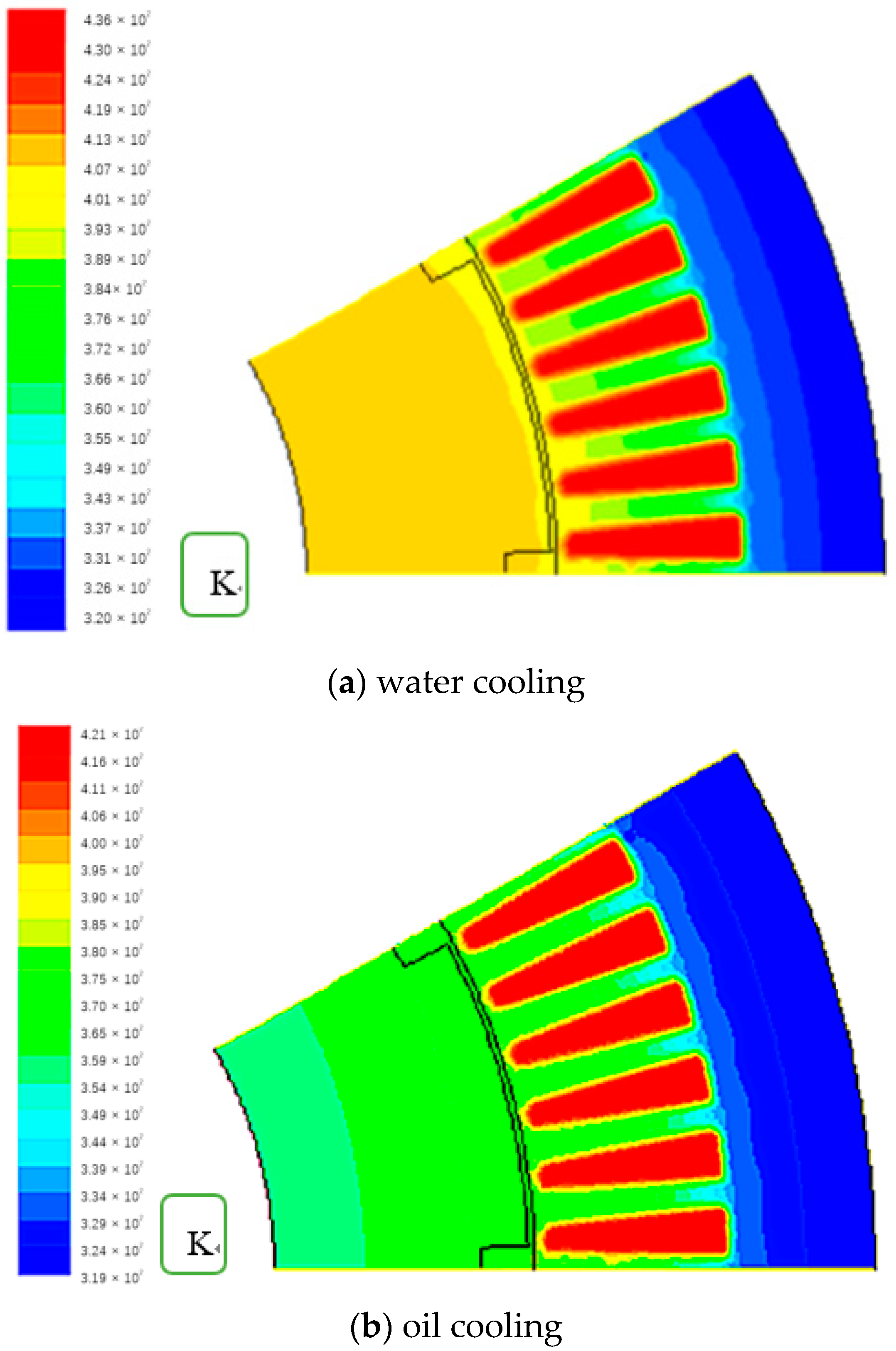






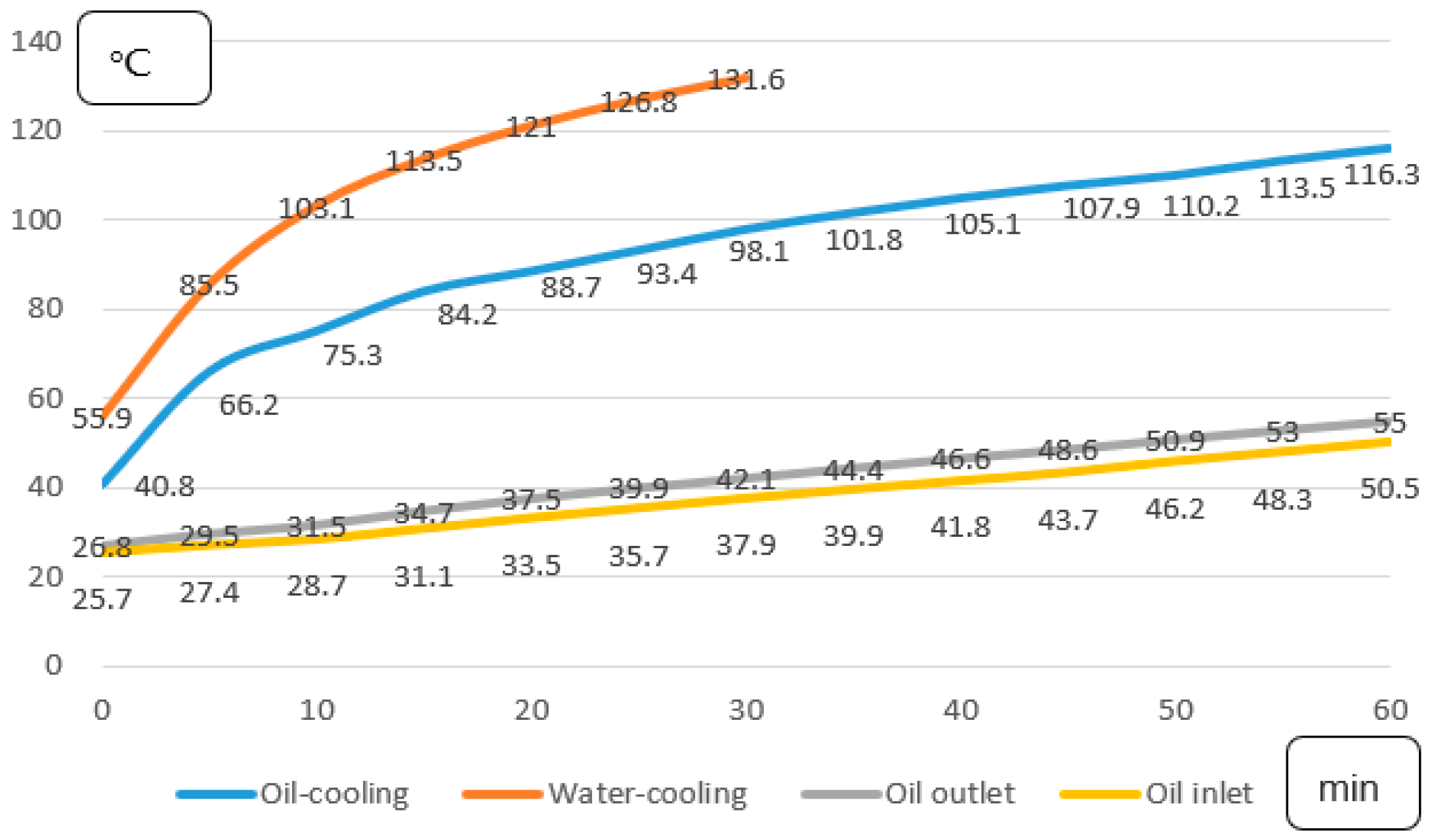
| pole logarithm | 3 |
| slot number | 72 |
| motor rating (kw) | 90 |
| rated speed (rpm) | 2500 |
| permanent magnets | YXG30 |
| maximum torque (Nm) | 1800 |
| air gap length (mm) | 10 |
| motor quality (kg) | 96 |
| copper space factor | 71% |
| Output Speed (r/min) | Output Torque (Nm) | Input DC Voltage (V) | Input DC Current (A) | System Efficiency |
|---|---|---|---|---|
| 97 | 1781 | 297 | 192 | 31.7% |
| 190 | 1750 | 297 | 297 | 39.4% |
| 286 | 1800 | 297 | 362 | 50.1% |
| 380 | 1811 | 297 | 445 | 54.5% |
| 479 | 1781 | 299 | 476 | 62.7% |
| Time | 0 s | 60 s |
|---|---|---|
| torque (Nm) | 1418 | 1235 |
| speed (r/min) | 70 | 70 |
| inlet-oil temperature (°C) | 49.2 | 49.3 |
| outlet-oil temperature (°C) | 49.4 | 50.5 |
| winding temperature (°C) | 59.8 | 130.3 |
| input dc voltage (V) | 165 | 165 |
| input dc current (A) | 212 | 178 |
| system efficiency | 29.7% | 30.6% |
© 2019 by the authors. Licensee MDPI, Basel, Switzerland. This article is an open access article distributed under the terms and conditions of the Creative Commons Attribution (CC BY) license (http://creativecommons.org/licenses/by/4.0/).
Share and Cite
Guo, F.; Zhang, C. Oil-Cooling Method of the Permanent Magnet Synchronous Motor for Electric Vehicle. Energies 2019, 12, 2984. https://doi.org/10.3390/en12152984
Guo F, Zhang C. Oil-Cooling Method of the Permanent Magnet Synchronous Motor for Electric Vehicle. Energies. 2019; 12(15):2984. https://doi.org/10.3390/en12152984
Chicago/Turabian StyleGuo, Fulai, and Chengning Zhang. 2019. "Oil-Cooling Method of the Permanent Magnet Synchronous Motor for Electric Vehicle" Energies 12, no. 15: 2984. https://doi.org/10.3390/en12152984
APA StyleGuo, F., & Zhang, C. (2019). Oil-Cooling Method of the Permanent Magnet Synchronous Motor for Electric Vehicle. Energies, 12(15), 2984. https://doi.org/10.3390/en12152984





